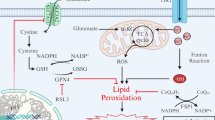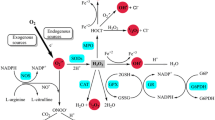Abstract
Mitochondrial glutathione pool is vital in protecting cells against oxidative stress as the majority of the cellular reactive oxygen species are generated in mitochondria. Oxidative stress is implicated as a causative factor in neuronal death in neurodegenerative disorders. We hypothesized that depletion of mitochondrial glutathione leads to mitochondrial dysfunction and apoptotic death of SK-N-SH (human neuroblastoma) cells and investigated the neuroprotective strategies against GSH depletion. SK-N-SH cells were treated with two distinct inhibitors of glutathione metabolism: L-buthionine-(S, R)-sulfoximine (BSO) and ethacrynic acid (EA). EA treatment caused depletion of both the total and mitochondrial glutathione (while BSO had no effect on mitochondrial glutathione), enhanced rotenone-induced ROS production, and reduced the viability of SK-N-SH cells. Glutathione depletion by BSO or EA demonstrated positive features of mitochondria-mediated apoptosis in neuroblastoma cell death. Prevention of apoptosis by Bcl2 overexpression or use of antioxidant ebselen did not confer neuroprotection. Co-culture with U-87 (human glioblastoma) cells protected SK-N-SH cells from the cell death. Our data suggest that depletion of mitochondrial glutathione leads to mitochondrial dysfunction and apoptosis. The study indicates that preventing mitochondrial glutathione depletion could become a novel strategy for the development of neuroprotective therapeutics in neurodegenerative disorders.







Similar content being viewed by others
Abbreviations
- BSO:
-
L-Buthionine-(S,R)-sulfoximine
- EA:
-
Ethacrynic acid
- ETC:
-
Electron transport chain
- GSH:
-
Glutathione
- PI:
-
Propidium iodide
- ROS:
-
Reactive oxygen species
- SK-N-SH:
-
A human neuroblastoma cell line
- U-87:
-
A human glioblastoma cell line
References
Riederer P, Sofic E, Rausch WD, Schmidt B, Reynolds GP et al (1989) Transition metals, ferritin, glutathione, and ascorbic acid in parkinsonian brains. J Neurochem 52:515–520
Meister A (1988) Glutathione metabolism and its selective modification. J Biol Chem 263:17205–17208
Griffith OW (1999) Biologic and pharmacologic regulation of mammalian glutathione synthesis. Free Radic Biol Med 27:922–935
Griffith OW, Meister A (1979) Potent and specific inhibition of glutathione synthesis by buthionine sulfoximine (S-n-butyl homocysteine sulfoximine). J Biol Chem 254:7558–7560
Griffith OW, Meister A (1985) Origin and turnover of mitochondrial glutathione. Proc Natl Acad Sci USA 82:4668–4672
Ploemen JH, Van Schanke A, Van Ommen B, Van Bladeren PJ (1994) Reversible conjugation of ethacrynic acid with glutathione and human glutathione S-transferase P1–1. Cancer Res 54:915–919
Muyderman H, Nilsson M, Sims NR (2004) Highly selective and prolonged depletion of mitochondrial glutathione in astrocytes markedly increases sensitivity to peroxynitrite. J Neurosci 24:8019–8028
Muyderman H, Wadey AL, Nilsson M, Sims NR (2007) Mitochondrial glutathione protects against cell death induced by oxidative and nitrative stress in astrocytes. J Neurochem 102:1369–1382
Fernandez-Checa JC (2003) Redox regulation and signaling lipids in mitochondrial apoptosis. Biochem Biophys Res Commun 304:471–479
Sims NR, Nilsson M, Muyderman H (2004) Mitochondrial glutathione: a modulator of brain cell death. J Bioenerg Biomembr 36:329–333
Huang J, Philbert MA (1996) Cellular responses of cultured cerebellar astrocytes to ethacrynic acid-induced perturbation of subcellular glutathione homeostasis. Brain Res 711:184–192
Reichelt KL, Fonnum F (1969) Subcellular localization of N-acetyl-aspartyl-glutamate, N-acetyl-glutamate and glutathione in brain. J Neurochem 16:1409–1416
Raps SP, Lai JC, Hertz L, Cooper AJ (1989) Glutathione is present in high concentrations in cultured astrocytes but not in cultured neurons. Brain Res 493:398–401
Dringen R, Hirrlinger J (2003) Glutathione pathways in the brain. Biol Chem 384:505–516
Dringen R, Gutterer JM, Hirrlinger J (2000) Glutathione metabolism in brain metabolic interaction between astrocytes and neurons in the defense against reactive oxygen species. Eur J Biochem 267:4912–4916
Meister A, Anderson ME (1983) Glutathione. Annu Rev Biochem 52:711–760
Martensson J, Lai JC, Meister A (1990) High-affinity transport of glutathione is part of a multicomponent system essential for mitochondrial function. Proc Natl Acad Sci USA 87:7185–7189
Lash LH (2006) Mitochondrial glutathione transport: physiological, pathological and toxicological implications. Chem Biol Interact 163:54–67
Nakamura Y, Feng Q, Kumagai T, Torikai K, Ohigashi H et al (2002) Ebselen, a glutathione peroxidase mimetic seleno-organic compound, as a multifunctional antioxidant. Implication for inflammation-associated carcinogenesis. J Biol Chem 277:2687–2694
Lai JC, Clark JB (1976) Preparation and properties of mitochondria derived from synaptosomes. Biochem J 154:423–432
Clark JB, Lai JC (1989) Glycolytic, tricarboxylic acid cycle and related enzymes in brain. In: Butterworth RF (ed) Boulton AA BG. Humana, NeuroMethods. Clifton, pp 233–281
Griffith OW (1980) Determination of glutathione and glutathione disulfide using glutathione reductase and 2-vinylpyridine. Anal Biochem 106:207–212
Li N, Ragheb K, Lawler G, Sturgis J, Rajwa B et al (2003) Mitochondrial complex I inhibitor rotenone induces apoptosis through enhancing mitochondrial reactive oxygen species production. J Biol Chem 278:8516–8525
Chresta CM, Masters JR, Hickman JA (1996) Hypersensitivity of human testicular tumors to etoposide-induced apoptosis is associated with functional p53 and a high Bax:Bcl-2 ratio. Cancer Res 56:1834–1841
Walker JE, Skehel JM, Buchanan SK (1995) Structural analysis of NADH: ubiquinone oxidoreductase from bovine heart mitochondria. Methods Enzymol 260:14–34
Zheng L, Dengler TJ, Kluger MS, Madge LA, Schechner JS et al (2000) Cytoprotection of human umbilical vein endothelial cells against apoptosis and CTL-mediated lysis provided by caspase-resistant Bcl-2 without alterations in growth or activation responses. J Immunol 164:4665–4671
Ransom B, Behar T, Nedergaard M (2003) New roles for astrocytes (stars at last). Trends Neurosci 26:520–522
Schulz JB, Lindenau J, Seyfried J, Dichgans J (2000) Glutathione, oxidative stress and neurodegeneration. Eur J Biochem 267:4904–4911
Griffin S, Clark JB, Canevari L (2005) Astrocyte-neurone communication following oxygen-glucose deprivation. J Neurochem 95:1015–1022
Finsterer J (2004) Mitochondriopathies. Eur J Neurol 11:163–186
Green DR, Reed JC (1998) Mitochondria and apoptosis. Science 281:1309–1312
Adams JM, Cory S (1998) The Bcl-2 protein family: arbiters of cell survival. Science 281:1322–1326
Chao DT, Korsmeyer SJ (1998) BCL-2 family: regulators of cell death. Annu Rev Immunol 16:395–419
Spierings D, McStay G, Saleh M, Bender C, Chipuk J et al (2005) Connected to death: the (unexpurgated) mitochondrial pathway of apoptosis. Science 310:66–67
Makin GW, Corfe BM, Griffiths GJ, Thistlethwaite A, Hickman JA et al (2001) Damage-induced Bax N-terminal change, translocation to mitochondria and formation of Bax dimers/complexes occur regardless of cell fate. EMBO J 20:6306–6315
Werner P, Cohen G (1993) Glutathione disulfide (GSSG) as a marker of oxidative injury to brain mitochondria. Ann N Y Acad Sci 679:364–369
Jain A, Martensson J, Stole E, Auld PA, Meister A (1991) Glutathione deficiency leads to mitochondrial damage in brain. Proc Natl Acad Sci USA 88:1913–1917
Meister A (1995) Mitochondrial changes associated with glutathione deficiency. Biochim Biophys Acta 1271:35–42
de la Asuncion JG, Millan A, Pla R, Bruseghini L, Esteras A et al (1996) Mitochondrial glutathione oxidation correlates with age-associated oxidative damage to mitochondrial DNA. Faseb J 10:333–338
Isaac AO, Dukhande VV, Lai JC (2007) Metabolic and antioxidant system alterations in an astrocytoma cell line challenged with mitochondrial DNA deletion. Neurochem Res 32:1906–1918
Merad-Boudia M, Nicole A, Santiard-Baron D, Saille C, Ceballos-Picot I (1998) Mitochondrial impairment as an early event in the process of apoptosis induced by glutathione depletion in neuronal cells: relevance to Parkinson’s disease. Biochem Pharmacol 56:645–655
Chi L, Ke Y, Luo C, Gozal D, Liu R (2007) Depletion of reduced glutathione enhances motor neuron degeneration in vitro and in vivo. Neuroscience 144:991–1003
Seyfried J, Soldner F, Schulz JB, Klockgether T, Kovar KA et al (1999) Differential effects of L-buthionine sulfoximine and ethacrynic acid on glutathione levels and mitochondrial function in PC12 cells. Neurosci Lett 264:1–4
Wullner U, Seyfried J, Groscurth P, Beinroth S, Winter S et al (1999) Glutathione depletion and neuronal cell death: the role of reactive oxygen intermediates and mitochondrial function. Brain Res 826:53–62
Dukhande VV, Malthankar-Phatak GH, Hugus JJ, Daniels CK, Lai JC (2006) Manganese-induced neurotoxicity is differentially enhanced by glutathione depletion in astrocytoma and neuroblastoma cells. Neurochem Res 31:1349–1357
Acknowledgments
This study was supported by a grant from Idaho Biomedical Research Infrastructure Network (NIH NCRR BRINIP20RR016454) to JCKL, Idaho State University GSRSC pre-doctoral grant to VVD and NIH RO1 DK077910 to ALMB. We are thankful for the important suggestions from Drs. Christopher Daniels, Alok Bhushan and Leslie Devaud. VVD thanks the Idaho INBRE NIH program (grant # P20RR016454) for a research fellowship.
Author information
Authors and Affiliations
Corresponding authors
Electronic supplementary material
Below is the link to the electronic supplementary material.
Rights and permissions
About this article
Cite this article
Dukhande, V.V., Kawikova, I., Bothwell, A.L. et al. Neuroprotection against neuroblastoma cell death induced by depletion of mitochondrial glutathione. Apoptosis 18, 702–712 (2013). https://doi.org/10.1007/s10495-013-0836-4
Published:
Issue Date:
DOI: https://doi.org/10.1007/s10495-013-0836-4




